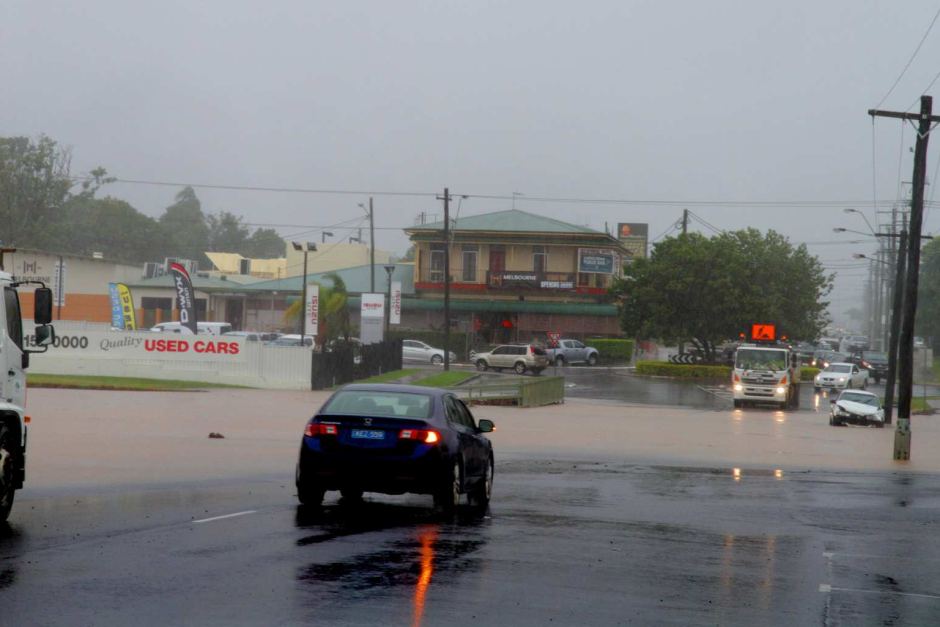In a land where drought often reigns supreme, Queensland is currently rewriting its narrative with an unusual twist: heavy rainfall that seems endless. From cotton fields to coastal towns, this relentless downpour has turned life upside down across the state. As umbrellas become must-have accessories for all residents and roads morph into treacherous waterways overnight, one cannot help but wonder what celestial forces are at play here. Is this nature’s compensation for years of dry spells or merely another chapter in her unpredictable chronicles? Join us as we delve into the fascinating world of Queensland’s heavy rainfall – a phenomenon that challenges our perception of this sunburnt land while reminding us just how little control we truly have over our environment.

Overview of heavy rainfall in Queensland
Queensland, known as the Sunshine State, is no stranger to heavy rainfall. This coastal region experiences tropical storms and monsoonal rains that can rapidly transform from gentle drizzles to torrential downpours. The heavy rainfall in Queensland is a double-edged sword – on the one hand, it provides a much-needed water supply for agriculture and sustains the diverse ecosystems of the Great Barrier Reef. On the other hand, it often leads to flash floods that wreak havoc on infrastructure and communities.
One fascinating aspect of heavy rainfall in Queensland is its unpredictable nature. While tropical cyclones are generally responsible for most intense rain events, even non-cyclonic systems can bring heavy downpours due to atmospheric instability or local meteorological phenomena. In addition, the geography of Queensland plays a significant role in determining which areas receive the most rain – from soaking mountain ranges like the Great Dividing Range to flat inland plains that become vast floodplains during extreme rainfall events.
The impacts of heavy rainfall extend far beyond flooded streets and soggy backyards. Surprisingly enough, these intense precipitation events have been found to increase groundwater levels in some regions of Queensland. This has important implications for water resource management and long-term sustainability efforts in this arid state. Moreover, heavy rainfall can also impact water quality by washing pollutants into rivers and oceans, affecting both humans and marine life alike.
Overall, understanding heavy rainfall patterns in Queensland requires considering a combination of climatic factors such as tropical cyclones.
El Nino and La Nina Cycles
The heavy rainfall experienced in Queensland can be attributed to the influence of the El Nino and La Nina cycles. These natural phenomena significantly affect weather patterns globally, particularly in the Pacific Ocean region. El Nino occurs when warm ocean currents displace colder currents, leading to warmer waters and altered atmospheric conditions. This disruption can result in increased rainfall in certain areas, like Queensland.
While El Nino is often associated with drought conditions due to its impact on precipitation patterns, its counterpart, La Nina, has the opposite effect. La Nina occurs when cooler ocean currents dominate, leading to below-average sea surface temperatures and heightened rainfall events. This cycle is currently influencing weather patterns worldwide and has contributed to the heavy downpours experienced in Queensland.
Understanding these climate cycles is essential for predicting extreme weather events and implementing effective disaster management strategies. As unpredictable as they may seem at times, El Nino and La Nina cycles provide valuable insight into future weather patterns—knowledge that can save lives and ensure communities are better prepared for the impacts of heavy rainfall events such as those witnessed recently in Queensland.
Climate Change and Global Warming
Climate change and global warming have been major concerns for decades, with scientists continuously warning about the devastating impacts they can have on our planet. Heavy rainfall in Queensland serves as a stark reminder of how extreme weather events are becoming more frequent and intense due to climate change. The increase in greenhouse gas emissions is causing the Earth’s temperature to rise, leading to a disruption in weather patterns and an increase in precipitation.
Australia, known for its hot and dry climate, is experiencing unprecedented rainfall that overwhelms its infrastructure and agricultural systems. This not only poses immediate risks, such as floods and landslides but also has long-term consequences for food security and water resources. Moreover, heavy rainfall can lead to soil erosion and nutrient depletion, affecting the health of ecosystems.
The occurrence of intense rainfall events like those seen in Queensland should serve as a wake-up call for governments around the world to take urgent action against climate change. It highlights the need to shift towards renewable energy sources, reduce greenhouse gas emissions, improve urban planning strategies to mitigate flooding risks and invest in sustainable agriculture practices. Only by addressing these root causes can we hope to prevent more catastrophic weather events linked to global warming from ravaging our planet’s delicate ecosystems.
Topography of Queensland
The topography of Queensland is as diverse as its weather patterns. From the rugged mountains of the Great Dividing Range to the flat plains of the Darling Downs, this Australian state boasts a wide range of landscapes that contribute to its unique climate and rainfall patterns. The coastal regions feature sandy beaches and rocky cliffs, while further inland, vast grasslands stretch into the horizon. These different landforms interact with air masses coming from both the east and west, resulting in highly localized variations in precipitation.
One fascinating aspect of Queensland’s topography is its network of river systems. The state is home to numerous large rivers, such as the Fitzroy and Burdekin rivers, which drain into estuaries along the coast. These river systems play a crucial role in distributing rainfall across different regions, especially during periods of heavy rain. As water rushes down from higher elevations towards lower areas, it creates a natural drainage system that helps regulate runoff and prevent flooding.
In addition to rivers, Queensland also boasts several iconic geological formations contributing to its rugged beauty. The Glass House Mountains in southeastern Queensland are a series of volcanic plugs that rise dramatically from the surrounding landscape, creating an awe-inspiring sight for visitors. Further north, near Cairns, lies Australia’s highest peak outside of mainland Tasmania: Mount Bartle Frere. Its majestic presence not only adds character to Queensland’s topography but also influences local weather patterns by acting as a barrier to prevailing winds coming from the Coral Sea.

Floods and Flash Floods
Floods and flash floods are natural disasters that can pose significant dangers to both human life and the environment. Queensland, Australia, is no stranger to heavy rainfall and the subsequent flooding it brings. These events can occur suddenly, devastating entire communities in a matter of hours. While flood warnings are put in place to give residents some time to prepare, flash floods often catch people off guard due to their rapid onset.
What makes floods particularly dangerous is not only the sheer volume of water but also the speed at which it can move. Flash floods, for instance, occur when there is an immense amount of rainfall in a short period of time or when a dam fails. As a result, large amounts of water rush through narrow valleys or urban areas, wreaking havoc along its path. This makes evacuation even more challenging as roads may quickly become impassable and escape routes cut off.
Although the devastation caused by flooding cannot be understated, it’s important to remember that these natural events serve an ecological purpose as well. Floods replenish groundwater supplies and redistribute sediments across river systems. They play an essential role in balancing ecosystems by providing nutrients for plants and animals alike. However, human settlements have often altered natural drainage patterns through construction projects or deforestation, making vulnerable areas more prone to flooding.
Understanding how floods occur and their potential effects helps us better prepare for such events in the future by investing in proper infrastructure like upgraded drainage systems and early warning systems equipped with real-time data analysis capabilities.
Damage to Infrastructure and Property
The heavy rainfall in Queensland has resulted in severe damage to infrastructure and property across the region. Roads have become inundated with floodwaters, causing them to collapse or become completely impassable. Bridges have been washed away, cutting off entire communities’ essential services such as healthcare and groceries. The force of the water has also caused landslides, destroying homes and leaving families displaced.
Additionally, the torrential rains have wreaked havoc on residential and commercial properties. Many buildings have experienced roof leaks or flooding, leading to extensive damage to both the structure itself and its contents. Businesses are facing significant financial losses as they struggle to recover from water damage and repair equipment. Homeowners are left grappling with ruined belongings and mounting repair bills.
While natural disasters like heavy rainfall can be devastating, we must learn from these events and take necessary measures to prevent similar damage in the future. Building resilient infrastructure that can withstand extreme weather conditions is a top priority for governments at all levels. Furthermore, increased investment in early warning systems can help alert residents ahead of time so they can take necessary precautions to protect their property.
The heavy rainfall in Queensland has had far-reaching consequences for infrastructure and property. From collapsed roads to flooded houses, communities are left dealing with significant physical and financial burdens as a result of this natural disaster. Moving forward, steps must be taken to ensure buildings are prepared for extreme weather events while also equipping individuals with tools for proactive action during emergencies.
Disruption of transportation and services
The heavy rainfall in Queensland not only caused widespread flooding and property damage but also disrupted transportation and essential services across the region. With roads submerged under water, public transport systems came to a grinding halt, leaving commuters stranded and isolated. Additionally, water inundation caused power outages in many areas, cutting electricity supply to households and businesses alike.
As we grapple with the aftermath of this natural disaster, it becomes clear that there is an urgent need for improved infrastructure and contingency plans to handle such events. The disruption of transportation networks highlights the vulnerability of our current systems to extreme weather conditions. It raises questions about the resilience of our road networks, bridges, and public transport systems in the face of climate change-induced disasters like heavy rainfall.
Furthermore, the breakdown in essential services such as electricity emphasizes investing in renewable energy sources and strengthening our power grid infrastructure. This flooding event serves as a wake-up call for governments and policymakers to prioritize long-term planning considering climate change adaptation measures alongside sustainable development goals.
While heavy rainfall in Queensland has wreaked havoc on communities through floods and property damage, it has also brought attention to significant vulnerabilities within our transportation and service infrastructure. From disrupted public transport to power outages, this natural disaster reminds us of the need for proactive planning that integrates climate resilience into our everyday lives. It’s high time we address these weaknesses head-on by investing in innovative solutions that will help us weather future storms more effectively.
Emergency Management Strategies and Plans
Emergency management strategies and plans play a crucial role in mitigating the impacts of heavy rainfall and ensuring the safety and well-being of communities. In Queensland, where heavy rainfall is not uncommon, authorities have put in place robust measures to respond to emergencies effectively. One such strategy is the establishment of comprehensive communication systems that enable quick dissemination of vital information to residents regarding potential risks and emergency procedures. These systems include various channels such as text messages, sirens, social media platforms, and local radio stations.
Additionally, Queensland’s emergency management plans focus on proactive preparation rather than reactive response. This involves conducting regular simulations and exercises to test the efficiency of emergency procedures and identify areas for improvement. By practising response protocols beforehand, emergency services can better anticipate challenges that may arise during extreme weather events. Furthermore, partnering with local community organizations plays an essential role in broadening resources for emergency situations. These partnerships facilitate enhanced coordination among stakeholders in terms of evacuations, shelter arrangements, medical aid distribution, and other critical services needed during heavy rainfall episodes.
Community Preparedness and Resilience
Community preparedness and resilience are crucial in the face of natural disasters like heavy rainfall. While the focus is often on the physical damage caused by these events, it is equally important to highlight the role that communities play in preparing for and recovering from such situations.
One aspect of community preparedness is the development of emergency response plans that outline procedures for evacuation, communication, and resource allocation. These plans help ensure that individuals know what to do when disaster strikes and are able to coordinate efforts effectively. Moreover, community members should be educated about potential risks associated with heavy rainfall and how to minimize their impact, such as through proper land use planning or building resilient infrastructure.
Another key factor in community resiliency is social cohesion. Strong connections between neighbours can foster a sense of collective responsibility during challenging times. By organizing support networks or programs that empower individuals to contribute their skills or resources, communities can better withstand the aftermath of heavy rainfall. With everyone pulling together towards a common goal, there’s a greater chance of quicker recovery and improved well-being for all involved.
Government Assistance and Support Programs
In times of natural disasters like heavy rainfall in Queensland, government assistance and support programs are crucial in ensuring the safety and well-being of affected communities. These programs are designed to provide immediate relief and aid to individuals and families impacted by such events. From emergency accommodation and food supplies to financial assistance for repairs, these initiatives aim to mitigate the adverse effects of the disaster.
Moreover, government assistance programs extend beyond necessities. They also focus on long-term recovery efforts, including infrastructure rebuilding projects and mental health support services. Through access to counselling services and community resilience programs, individuals can receive the necessary support to overcome trauma and rebuild their lives after experiencing significant loss or damage.
Governments at all levels need to collaborate with various agencies and organizations during disaster response efforts. This ensures that comprehensive help is provided promptly to those affected by heavy rainfalls or other natural disasters. By leveraging these government-assisted initiatives, communities can recover more effectively while receiving appropriate aid tailored to their specific needs.
Summary of Heavy Rainfall Impacts in Queensland
In recent years, heavy rainfall has become a recurring event in Queensland, wreaking havoc and leaving lasting impacts on both the environment and communities. The floods that accompany these downpours have resulted in the destruction of homes, loss of livestock, and extensive damage to infrastructure. In addition to immediate effects, such as road closures and power outages, heavy rainfall also poses long-term consequences for the region’s economy and ecosystem.
One significant impact of heavy rainfall in Queensland is the disruption it causes in transportation networks. Many roads become inundated or washed away completely, cutting off access to towns and isolating communities from essential services. This not only hampers emergency responses but also affects businesses dependent on transport links for their supply chain. Furthermore, damage to bridges and culverts can take months or even years to repair fully, causing ongoing inconvenience for residents who rely on these critical infrastructure connections.
Another notable consequence of heavy rainfall is its effect on agriculture in Queensland. Floodwaters can destroy crops and pasturelands, affecting farmers’ livelihoods significantly. In some cases, entire harvests may be decimated by excessive rainwater or rendered unfit for consumption due to contamination. Moreover, the loss of livestock due to flooding can result in financial losses for farmers who depend on their animals for income.
It is evident that heavy rainfall has far-reaching impacts beyond mere inconvenience; it disrupts lives and damages infrastructure networks vital for society’s functions, leading both individuals and businesses to face substantial challenges ahead as they struggle to recover from the devastation caused

